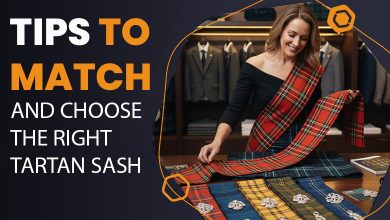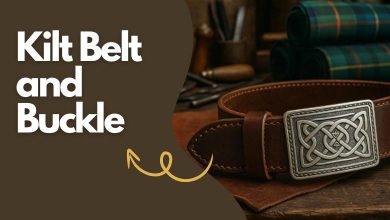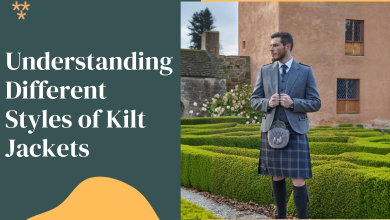Traditional Kilt Shirts for Today’s Modern Wear!

Scottish clothing traditionally includes kilt shirts. Regular shirts, T-shirts, down-button shirts, polo shirts, and many more are worn in the present period. Thus, the “Ghillie Shirt” was the first shirt worn by Scots with kilts. It is still popular and does not restrict itself to formal occasions. This variation is a bit different from regular shirts. However, traditional kilt shirts are our topic today. This article intends to teach you about the differences between ghillies and regular shirts, events to wear them, their evolution, and much more.
Table of Contents
ToggleGhillie Shirts vs. Regular Kilt Shirts: What’s the Difference?

Although Ghillie shirts are frequently confused with regular shirts, this is just a confusion since their fit and look are very different. The way they are made to fit also varies greatly. Similarly, the level of comfort offered by these two shirts is not the same.
Ghillie Shirts
Scottish people have traditionally worn Ghillie shirts, often called Jacobite or Jacobean shirts, with kilts. Because they fit loosely, they are different from other shirts. Leather or cotton laces tied in a knot or let free are frequently used to define a round or V-neckline. Compared to dress shirts or shirts with waistcoats, which are also worn with kilts, Scots view them as a more informal alternative.
Ghillie shirts are often tucked into the kilt with a belt and buckle. Some people also wear them with tartan pants for a relaxed yet traditional style. People consider them the oldest garments that remain in fashion as day wear. The most important point revealing their connection with the past is the association with the Jacobite rebellions.
Regular Shirts
Regular shirts, on the other hand, are a timeless, cozy, and adaptable shirt type that is neither excessively tight nor comfy. They have a laid-back, classic style that goes well with many body shapes and is appropriate for daily use. Unlike Ghillie shirts, regular shirts come with zip or button closures. Another important difference from kilt shirts is their usage on formal occasions only.
Understanding Collar Styles in Regular Kilt Shirts

Now that you know the differences between regular and Ghillie shirts. It’s time to move ahead and talk about kilt shirts. The first thing here is to understand the collar styles that regular kilts have. The shirts usually have three types of collars: wing, standard, and Victorian collars. Below is the description of these collars:
Wing Collar: Let’s start with a wing collar which is the most formal type of collar. It is typically seen in white and paired with a bow tie or a regular necktie. This collar variation is a suitable choice for weddings, dinners, and other formal events.
Standard Collar: When we talk about the more versatile collar option that is suitable for both formal and casual occasions, standard collars come to mind. Similarly, individuals can have this collar for a variety of neckties. Above all, they are a common choice for a range of events.
Victorian Collar: As the name represents, this collar variation became popular in the era of Queen Victoria. It offers a high (extending jawline or even higher), often detachable or decorative neckline. The variation is not common today but its connection with the Queen makes people wear it at traditional or festival celebrations.
Kilt Shirt Evolution From Highland Roots to Modern Looks
You might be surprised that kilt shirts were worn even before the invention of the great kilts. Historians find the first record of Ghillie shirts in 1575. They remained the common fabric in Scotland to pair with kilts for a considerable period. The basic style of the traditional shirt remained the same while some changes occurred with time. These changes appeared in the form of collars, fabric, and accessories to pair with shirts.
The evolution of kilt shirts started with kilts and they gained the name “Jacobite Shirt” during the Jacobite Rebellion. It remained silent from the imposition of the ban to its removal. Therefore, kilt attire gained more popularity after it while the shirt served as its important part. Today, Ghillie shirts are not only a part of tradition but also a source to modernize looks. Now, ghillie shirts are increasingly popular as a fashion statement, particularly within specific subcultures. Likewise, people who have a deep interest in historical or traditional attire prefer wearing it.
Tips to Choose the Right Jacobite Shirt
Every individual who wears traditional Scottish dress should know how to choose a Jacobite shirt. Doing so may sound easier, but there are some considerations. Ignoring them can compromise the comfort and ruin the charm of the overall dress.
Choosing the Right Material for Comfort and Style
Jacobite shirts are primarily made with cotton or linen. Poly-cotton blends or even pure polyester have also become common today, therefore, cotton or linen remains the priority. Cotton is smooth while linen becomes smooth with every wash. Linen performs well in summer because of its breathability but cotton’s breathability is a bit compromised. So choose the material according to your requirements.
Kilt Shirt Sizing Without the Guesswork
The next step is finding the exact size of the kilt shirt. Wearing it in the loose fitting is tradition to have maximum comfort. Its length should be 4-5 inches longer than an individual’s size. So he can easily tuck it into the kilt with the help of a leather belt. Likewise, sleeves must be a bit longer than standard shirts.
Color, Complementing the Kilt
The traditional color of Ghillie shirts is white with black laces but modernism has changed everything. Today, shirts come in different colors from black to brown and green. The color selection must be according to the shade of the kilt. The better idea is to choose a contrasting color. Remember, these shirts are wearable with all types of kilts for men, whether you prefer a denim or a tactical kilt.
How to Style and Wear a Ghillie Shirt
Styling a Ghillie shirt is all about blending tradition with comfort. Start by choosing a shirt that fits loosely and matches the color of your kilt—earthy tones for a strong touch, or white for a traditional style. Using a leather belt, secure the shirt in place inside the kilt. For a carefree, rustic look, tie the laces freely or leave them exposed around the neck. Wear it with ghillie brogues and knee-high socks to round off the classic Scottish look. Whether you are wearing it to a festival or a laid-back get-together, the Ghillie shirt guarantees everlasting appeal and authenticity.
When and Where to Wear Them
This question bothers many people. When can we put on Jacobite shirts? The above discussion must have revealed that this shirt variation is suitable for formal and semi-formal occasions. To provide more ease to them, we enlisted some common events including:
| Scottish Weddings | Burns Night Celebrations |
| Ceilidh & Dancing Events | Hogmanay |
| Festival Celebrations | Highland Games (as spectators) |
| Funerals | Graduation Ceremonies |
| St. Andrew’s Day | Black Tie Events |
Kilt Shirt Accessories: What Complements the Look?
A kilt shirt alone may look classic, but pairing it with the right accessories enhances the entire outfit. Here are some additions that not only bring out a traditional touch but also offer styling depth for modern wearers. Below are some essential accessories that perfectly complement a kilt shirt:
Jackets: A Prince Charlie or Argyll jacket instantly upgrades your look for formal occasions. For casual events, tweed or even leather jackets add a rugged edge to Ghillie shirts.
Waistcoats: Wearing a waistcoat over your kilt shirt, especially for semi-formal events, adds structure and sharpness to the outfit. Choose complementary tones for a balanced appearance.
Belts & Buckles: A wide leather belt with a decorative buckle helps secure the shirt inside the kilt while adding a bold accent to your waistline.
Brooches & Pins: Although subtle, a Celtic brooch or kilt pin enhances tradition and gives a polished finishing touch. Ideal for celebrations and cultural events.
Footwear: Ghillie brogues are the traditional go-to, but depending on the outfit’s formality, boots or even dress shoes can be appropriate. Match your shoes with the belt for a cohesive look.
Sporrans: These front pouches add utility and tradition. Choose a leather sporran for day wear, or go for fur or embossed versions for evening events.
Where to Buy Quality Kilt Shirts Online
Are you looking for a place to purchase a Jacobite shirt online? Your search ends here since a large selection of premium kilt shirts are available at The Utility Kilt. Our collection guarantees comfort, authenticity, and contemporary design. Choose the ideal addition to your kilt attire from our collection whether you need a shirt for a classic style or today’s contemporary attire.
FAQs About Kilt Shirts
Should I tuck my ghillie shirt in the kilt or leave it untucked?
Tucking a kilt shirt inside the kilt is the original way to dress it. On the other hand, you may leave it out of the kilt if you have to wear it to a casual gathering.
Do ghillie shirts come in different styles or are they all the same?
Do I need to wear anything under a ghillie shirt?
Should I match my kilt shirt color to my tartan or keep it neutral?
There is no strict law to match the shirt’s color with your kilt but it should complement. This is why wearing neutral colors like white, black, or any light shade is the primary recommendation.



